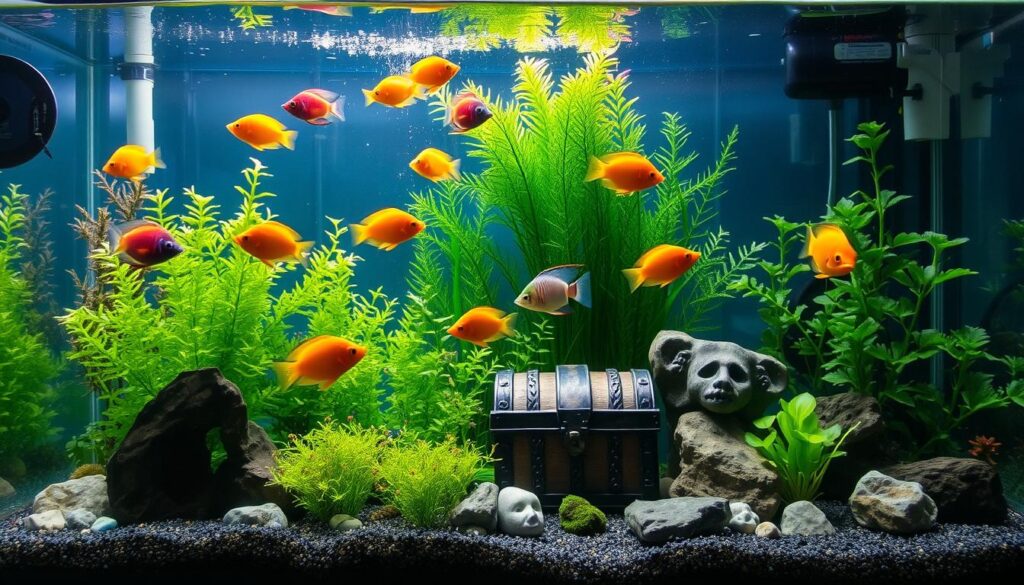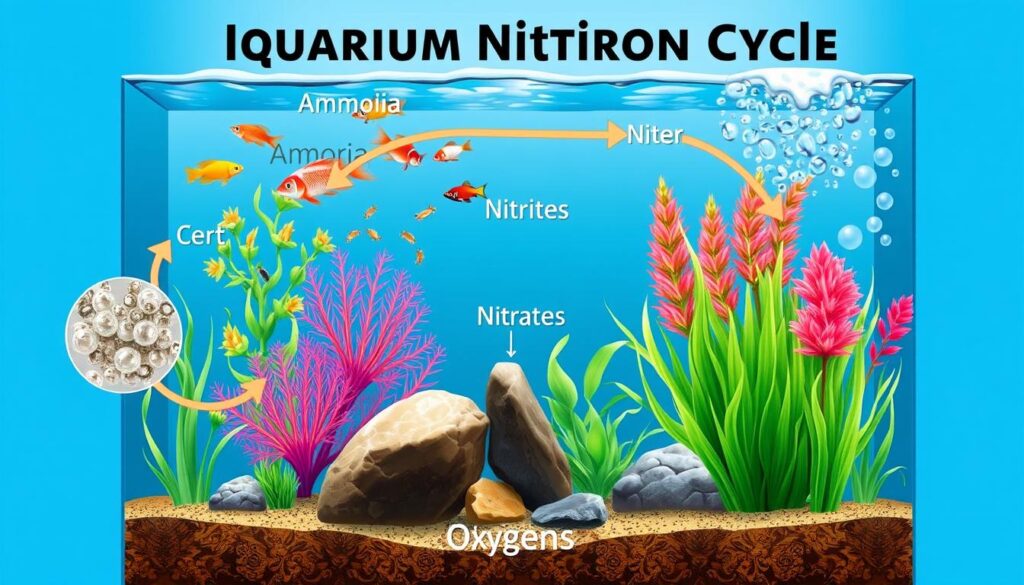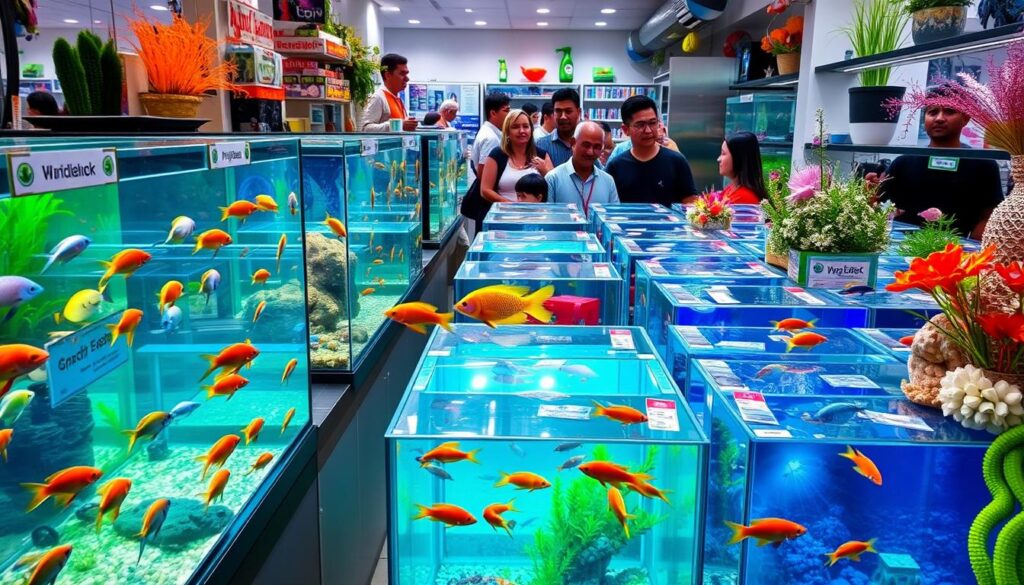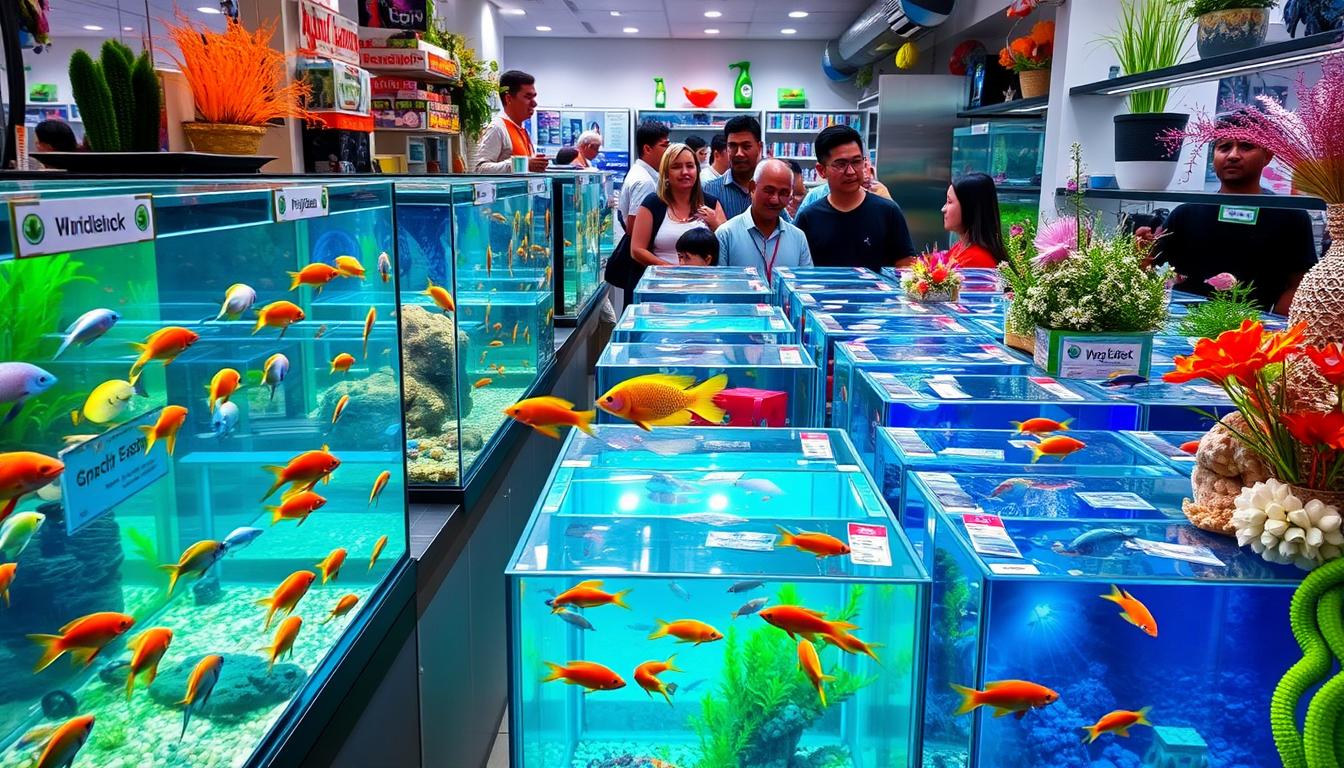Starting your journey in fishkeeping can be both exciting and challenging. This beginner’s aquarium guide offers key tips for fishkeeping for beginners. It helps you create a thriving underwater world and avoid common mistakes. You’ll learn about choosing the right tank size, keeping water quality high, and introducing fish. Aquarium Owners

Key Takeaways
- Choosing the right tank size is key for a balanced aquarium.
- Know the essential equipment needed for a healthy aquarium.
- Learn about the aquarium nitrogen cycle for good water quality.
- Use effective water management and stick to a regular maintenance schedule.
- Choose and introduce fish that fit well with your aquarium setup.
Getting Started: Tank Selection and Basic Equipment Setup
Starting your first fish tank is exciting but can feel overwhelming. Picking the right tank size and basic gear is key for a healthy aquarium. Let’s look at what beginners need to know.
Choosing the Right Tank Size
The tank size is a big decision that affects your aquarium’s health. A bigger tank is usually better because it’s more stable. Think about these things when picking a tank:
- The space you have in your home or office.
- The types of fish you want, as they need different sizes.
- The number of fish you plan to keep, to avoid water quality problems.
Essential Equipment Checklist
For a beginner aquarium, you’ll need some basic stuff:
- Tank and Stand: Pick a size that fits your space and fish plans.
- Filtration System: A good filter keeps the water clean.
- Aquarium Heater: Keep the water at the right temperature.
- Lighting: Good lighting helps plants and fish.
- Water Test Kit: Check the water to keep it balanced.
Proper Tank Placement
Where you put your tank is important for its health. Here are some tips:
- Avoid direct sunlight to stop algae.
- Keep the tank away from busy areas to reduce stress.
- Make sure the surface can hold a full tank.
By picking the right tank, gear, and spot, you’re on your way to a great fish tank setup and aquarium setup for your beginner aquarium.
Understanding the Aquarium Nitrogen Cycle
As a new aquarium owner, knowing about the nitrogen cycle is key. It’s a natural process that keeps your tank healthy. It’s important for your fish and other sea creatures to thrive.
The cycle changes harmful ammonia into safer nitrites and then nitrates. This change is thanks to good bacteria in your tank’s gravel, decorations, and filter.
- Ammonia (NH3) – Produced by fish waste and uneaten food, ammonia can be highly toxic to aquatic life.
- Nitrites (NO2) – Beneficial bacteria convert ammonia into nitrites, which are also harmful to fish.
- Nitrates (NO3) – The final stage of the nitrogen cycle, nitrates are less toxic and can be removed through water changes or absorbed by live plants.
It’s important to cycle your new tank to get the right bacteria. This takes 4-6 weeks. You’ll need to check the water often and change it regularly to keep ammonia, nitrites, and nitrates safe.
| Stage | Process | Ideal Range |
|---|---|---|
| Ammonia | Fish waste and uneaten food | 0 ppm |
| Nitrites | Conversion of ammonia by bacteria | 0 ppm |
| Nitrates | Final stage of nitrogen cycle | Less than 20 ppm |
Learning about the nitrogen cycle helps you create a safe home for your fish. Always test your water and adjust as needed to keep it perfect.

Essential Tips for First-Time Aquarium Owners
Keeping an aquarium alive needs careful attention to water quality, feeding, and upkeep. If you’re new to aquariums, these tips will guide you. They’ll help you create a lively, healthy underwater world.
Water Quality Management
Good water quality is key to a thriving aquarium. Test the water often for pH, temperature, and levels of ammonia, nitrites, and nitrates. Make adjustments to keep your fish happy. Also, change a bit of the water every week or two to keep it fresh.
Feeding Guidelines
Feeding your fish right is important for their health. Don’t overfeed, as it can harm the water. Give them a balanced diet of quality fish food. Watch how much they eat to avoid problems.
Regular Maintenance Schedule
Keeping your aquarium clean is crucial. Set up a cleaning schedule. This should include:
- Vacuuming the substrate to remove debris
- Cleaning the aquarium glass and decorations
- Checking and replacing filter media as needed
- Monitoring and maintaining water parameters
By following these tips, you’ll create a vibrant, healthy aquarium. Enjoy your first-time aquarium journey!
| Water Quality Parameter | Ideal Range |
|---|---|
| pH | 6.5 – 8.0 |
| Ammonia | 0 ppm |
| Nitrites | 0 ppm |
| Nitrates | 0 – 40 ppm |
“Maintaining a healthy aquarium is like cultivating a small, vibrant ecosystem in your own home. With the right care and attention, it can be a truly rewarding experience.”
Selecting and Introducing Fish to Your Tank
Choosing the right pet fish for your aquarium is key for new owners. When picking pet fish selection, think about compatibility, tank size, and water needs. This ensures a happy and healthy underwater world.
When picking fish species selection, think about who gets along. Some fish can be mean to others, causing stress or even death. It’s important to learn about each fish’s personality and how they get along.
- Choose fish that like the same water, like pH and temperature.
- Introduce new fish slowly, so everyone can get used to each other.
- Make sure there’s enough room and hiding spots to avoid fights and stress.
When stocking fish responsibly, don’t put too many in the tank. Too many fish can make the water dirty, cause fights, and harm your fish’s health.
“Responsible fish compatibility and stocking practices are the foundation for a thriving and balanced aquarium ecosystem.”
By picking the right fish, considering who gets along, and stocking wisely, you can make a great home for your fish. They’ll be happy and healthy in your aquarium.

Conclusion
Starting your aquarium journey is exciting. Remember, the tips in this guide are key to a great fishkeeping experience. You’ve chosen the right tank size, got the right equipment, and understand the nitrogen cycle.
Keeping water quality up, feeding right, and regular maintenance are vital. These essential tips for first-time aquarium owners help you create a beautiful beginner’s aquarium care setup. It will bring you joy for hours.
Being an aquarium owner is a journey of learning. But with this article’s help, you’re ready to be a confident fishkeeper. Enjoy the challenges, celebrate your wins, and cherish your underwater oasis.
FAQ
What are the essential equipment and supplies needed to set up a successful aquarium?
To start a beginner’s aquarium, you need a tank that fits your space. A good filter system, heater, and lighting are also key. Don’t forget substrate, décor, water testing kits, a gravel vacuum, and supplies for water changes.
How do I properly cycle a new aquarium?
Cycling a new tank is vital for a healthy environment. It takes 4-6 weeks. Start by adding ammonia and monitoring water. Let beneficial bacteria grow before adding fish.
What are the most important water quality factors to maintain in an aquarium?
Keep an eye on pH, ammonia, nitrites, nitrates, and temperature. Test the water often and change it partially to keep these levels right for your fish.
How often should I feed my fish and what types of food are best?
Feed your fish small amounts 2-3 times a day. High-quality food is best. A mix of flakes, pellets, frozen, and freeze-dried foods is good for their health.
What are some tips for selecting and introducing new fish to my aquarium?
Pick fish that fit your tank size and water type. Introduce them slowly and acclimate them well. Quarantine new fish for 2-4 weeks to prevent disease.
How do I maintain a healthy aquarium with live plants?
Live plants make your tank look natural and improve water quality. Choose easy plants, provide the right light, and use good substrate and nutrients. Regularly trim and care for your plants.
What are the most common signs of disease or distress in aquarium fish, and how should I address them?
Look out for lethargy, loss of appetite, color changes, and odd behavior. Fix water quality and compatibility issues first. For treatment, talk to a vet or experienced fishkeeper.




 No products in the cart.
No products in the cart.